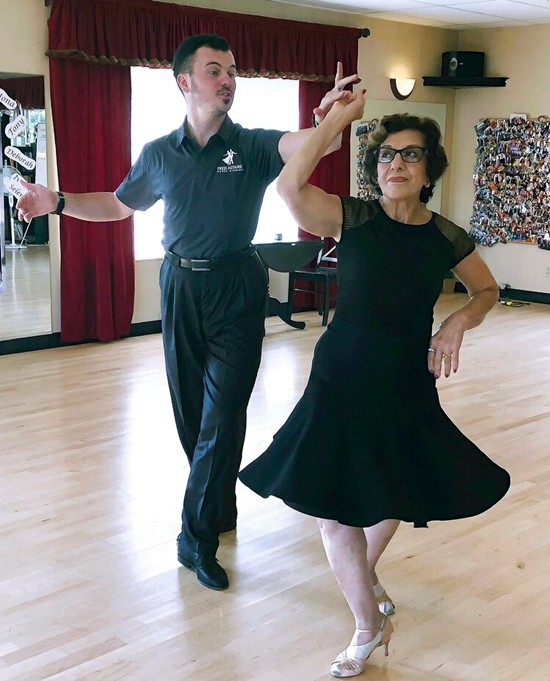
ORANGE, Conn. (AP) — When no Americans replied to her ads seeking a dance instructor, studio owner Chris Sabourin looked overseas. But she was stymied again by a federal tightening of visa application rules she and others contend is hampering the ballroom dance industry.
Sabourin had to eventually give up after a year and thousands of dollars trying to hire a top ballroom dancer from Greece to teach at her Fred Astaire studio in Orange, Connecticut, only to have the woman detained at New York’s Kennedy Airport and sent back home.
“It would just be nice to know why we’re having such a hard time,” Sabourin said. “It’s affecting our business, definitely.”
With a steady interest in learning iconic dances like the foxtrot and tango, fueled in part by “Dancing with the Stars,” studio owners like Sabourin say their efforts to hire professional instructors are hampered without overseas help.
The owners, national representatives of the Arthur Murray and Fred Astaire dance studio chains, and attorneys describe greater backlogs for visa applications and an overall increase in evidence requests, including for redundant information and unnecessary documents.
Immigration lawyers contend President Donald Trump’s administration has erected an “invisible wall” of hurdles that has made it difficult for all kinds of U.S. industries, from ballroom dance to STEM fields, to hire foreign workers for jobs they’ve had a difficult time filling with qualified Americans.
A review of United States Citizenship and Immigration Services data released in January by the American Immigration Lawyers Association found that average case processing time surged by 46% from fiscal year 2016, the last full year of the prior administration, to fiscal year 2018 — from 6.5 months to 9.48 months.
In congressional testimony provided in July, the association’s president, Marketa Lindt, said USCIS’s overall backlog of delayed cases exceeded 5.69 million this past fiscal year, a 69% increase over fiscal year 2014.
Meanwhile, federal records reviewed by The Associated Press show a slight uptick since 2017 in initial denials of O-1 visa applications from individuals with “extraordinary ability or achievement” — the visa that many of the foreign dancers seek — as well as for O-1 visa applicants who were given a second chance to meet eligibility requirements.
Representatives of the dance industry say they’ve seen the processing times for those nonimmigrant visas, which allow the dancers to work in the U.S. for up to three years, increase from weeks to months, with uncertainty the application will be approved.
In one case, a dancer approved to work at a Fred Astaire studio in Southbury, Connecticut, was later denied at the American consulate in his home country of Ecuador, one of the last steps in the process.
Jose Zuquilanda, 23, had hoped to compete, train, teach, dance and learn how to run a business at a Fred Astaire studio in Southbury, Connecticut.
Zuquilanda, who has visited the U.S. dozens of times on tourist visas, successfully obtained an O-1 visa but later was denied both that visa and his tourist visa at the consulate.
“They are not only harming his career, they’re harming the Fred Astaire studio,” said his mother, Liliana Serrano, who lives in Connecticut.
“I think these particular professionals, these artists, are falling into this area where USCIS and immigration services are just making it increasingly difficult to come here legally,” said Hartford, Connecticut, immigration attorney Erin O’Neil-Baker, who represents about 10 New England dance studios sponsoring foreign, professional ballroom dancers. “Even if you’re an expert in your field, even if you have extraordinary ability, to stay here, they make it difficult.”
Immigration attorneys point to the “Buy American and Hire American” executive order Trump signed in April 2017 as one reason for delays. The order was intended to create higher wages and employment rates for U.S. workers by “rigorously enforcing and administering” immigration laws.
“Across the board, across all types of applications at USCIS, we have observed a significant uptick in the increase in case processing time,” said Diane Rish, associate director of government relations for the American Immigration Lawyers Association.
The Government Accountability Office told members of Congress in late May it plans to investigate the report’s findings.
Mark Krikorian, executive director of the Center for Immigration Studies, which advocates for tighter immigration controls, said that he empathizes with small business owners but that they shouldn’t blame federal immigration policy for their labor recruitment problems.
“It’s one thing if you’re talking about world-renowned nuclear physicists, where there’s a handful of people on the planet who have an ability and we want them here. Everybody gets that,” he said. “Dance instructors? I’m sorry. That’s something for the market to deal with. If they can’t find people at dance programs in college to entice to be teachers, well, maybe we need fewer dance schools. This is a supply and demand issue.”
A spokeswoman for the U.S. Department of State said there has “been no policy change” regarding the O-1 visas specifically.
But Michael Wildes, an immigration attorney for first lady Melania Trump and her family, argued in an op-ed in The Hill that immigration lawyers for fashion designers, models and photographers have “experienced an unprecedented level of push-back from immigration authorities.”
He warned of “widespread disenfranchisement” among talented and creative people who decide to forgo the U.S. and opt for Paris or Beijing. Dance studio owners indeed said red tape can discourage prospective instructors and lead them to give up on the U.S.
“They can’t wait that long,” said John Gates, vice president of the Fred Astaire Dance Studios.
Wayne Smith, executive vice president of Arthur Murray Dance Centers, said, it can be expensive for his company’s dance studio owners to hire attorneys who understand immigration law.
“This is all the time, currently now. It’s just become a very difficult problem,” Smith said. “For them to invest that kind of money into it, it’s not really worth it to them in the long run.”
 |
 |
 |





